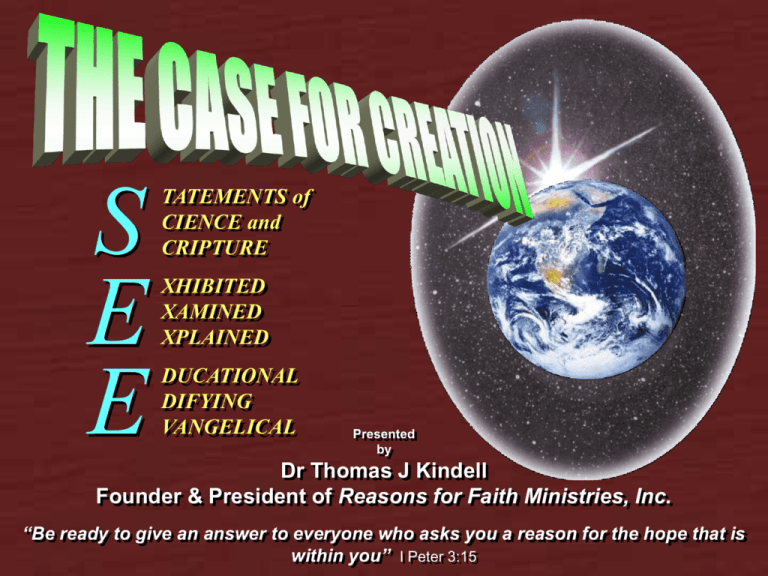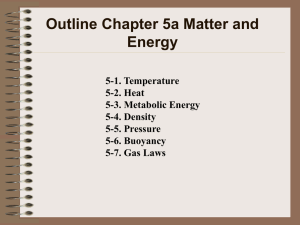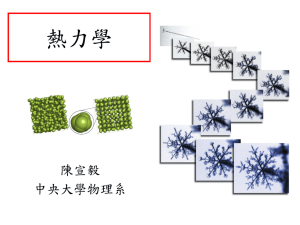Thermodynamics . ppt
advertisement

S E E TATEMENTS of CIENCE and CRIPTURE XHIBITED XAMINED XPLAINED DUCATIONAL DIFYING VANGELICAL Presented by Dr Thomas J Kindell Founder & President of Reasons for Faith Ministries, Inc. “Be ready to give an answer to everyone who asks you a reason for the hope that is within you” I Peter 3:15 IMPLICATIONS OF THE LAWS OF THERMODYNAMICS ORIGINS An emotional question. An unprovable question. Approaching the question properly. Let’s agree to use fair rules. “We take the side of science in spite of the patent absurdity of some of its constructs, in spite of its failure to fulfill many of its extravagant promises of health and life, in spite of the tolerance of the scientific community for unsubstantiated just-so-stories, because we have a prior commitment, a commitment to materialism. It is not that the methods and institutions of science somehow compel us to accept a material explanation of the phenomenal world,… …but, on the contrary, that we are forced by our a priori adherence to material causes to create an apparatus of investigation and set of concepts that produce material explanations, no matter how counter-intuitive, no matter how mystifying to the uninitiated. Moreover, that materialism is an absolute, for we cannot allow a Divine Foot in the door.” Richard Lewontin, “Billions and Billions of Demons,” The New York Review, January 9, 1997, p. 31 Definition - RELIGION “A set of beliefs concerning the cause, nature, and purpose of the universe.” The Random House College Dictionary, 1982. Rev. ed. Edited by Jess Stein, p. 1114 “[Evolution] is a general postulate to which all theories, all hypotheses, all systems must henceforward bow and which they must satisfy in order to be thinkable and true. Evolution is a light which illuminates all facts, a trajectory which all lines of thought must follow – that is what evolution is.” P. T. de Chardin, as quoted by F. J. Ayala, Journal of Heredity 68:3-10, 1977 What happened to the classic definition of science? Science: The search for truth [whatever that truth may be] through the scientific method of repeated experimentation and observation. Science Redefined as Materialism: You may search for truth – but only where and how we tell you to. Only materialistic explanations are allowed. THE PROBLEM Whenever you allow your opponent to define the rules of argument – you lose! The First Rule “I set the rules and you don’t!” The Second Rule “Heads, I win – Tails, you lose!” CONCLUSION The search for truth, for truth’s own sake, is unimportant – the only thing that matters is that a materialist victory is assured by controlling the definition of “science” so that no matter what – they have to win – by definition. It doesn’t matter if all the evidence supports intelligent design and contradicts naturalistic evolution. Dr. Scott Todd, an immunologist at Kansas State University said in Nature magazine: “Even if all the data point to an intelligent designer, such an hypothesis is excluded from science because it is not naturalistic.” S. D. Todd, Nature 410(6752):423, September 30, 1999 SCIENCE - OR JUST PHILOSOPHICAL BIAS? “[Evolution is] a theory universally accepted not because it can be proved by logically coherent evidence to be true, but because the only alternative, special creation, is clearly incredible.” D. M. S. Watson “Evolution is unproved and unprovable. We believe it because the only alternative is special creation which is unthinkable.” Sir Arthur Keith “The only alternative [to evolution] is the doctrine of special creation, which may be true, but is irrational.” L. T. More “We find that while ID arguments may be true,… ID is not science.” U. S. Dist. Judge, John Jones How can the truth be irrational and unscientific? A DOUBLE STANDARD REGARDING INTELLIGENT DESIGN? THE DOUBLE-EDGED SWORD OF SCIENCE “A hypothesis is empirical or scientific only if it can be tested by experience. A hypothesis or theory which cannot be, at least in principle, falsified by empirical observations and experiments does not belong to the realm of science.” F. J. Ayala, “Biological Evolution: Natural Selection or Random Walk?”, American Scientist, Vol. 62, p. 700 “In accepting evolution as a fact, how many biologists pause to reflect that science is built upon theories that have been proved by experiment to be correct, or remember that the theory of animal evolution has never been thus proved? “The fact of evolution is the backbone of biology, and biology is thus in the peculiar position of being a science founded on an unproved theory...Is it then a science or a faith? Belief in the theory of evolution is thus exactly parallel to belief in creation...both are concepts which believers know to be true but neither, up to the present, has been capable of proof.” L. Harrison Matthews, Introduction to The Origin of Species, 1971 Edition COMPARING MODELS Neither evolution or creation qualify as scientific theories. The evolution and creation hypotheses do qualify to be discussed and compared as scientific models. The Second Law of Thermodynamics Complexity Disorder Less Energy Available for Use “The entropy also measures the randomness…of the system: The greater the randomness, the greater the entropy.” Harold Blum - Evolutionist Physicist “…The Second Law of Thermodynamics…says, roughly speaking, that in any change the Universe becomes a slightly more disorderly place; the entropy goes up, the information content goes down. This natural tendency towards disintegration and chaos is evident all around us…” P. Davies, “Chance or choice: Is the Universe an accident?”, 80 New Scientist, p. 506 EVERYTHING THAT HAD A BEGINNING REQUIRES A CAUSE TO EXPLAIN ITS ORIGIN 1. The Universe (including time itself) can be shown to have had a beginning. 2. It is unreasonable to believe something could begin to exist without a cause. 3. The Universe therefore requires a cause. 4. God, as Creator of time, is outside of time. Since therefore He has no beginning in time, He has always existed, so doesn’t need a cause. The First Cause of limitless Space Must be infinite The First Cause of endless Time Must be eternal The First Cause of boundless Energy Must be omnipotent The First Cause of universal interrelationships Must be omnipresent The First Cause of supreme Complexity Must be omniscient The First Cause of Moral Values Must be moral The First Cause of Spiritual Values Must be spiritual The First Cause of Human Responsibility Must be volitional The First Cause of Human Integrity Must be truthful The First Cause of Human Love Must be loving The First Cause of Life Must be living NOTHING – THE PREFERRED CAUSE It is tempting to go one step further and speculate that the entire universe evolved from literally nothing. Allan H. Guth & Paul J Steinhardt ...that our Universe had its physical origin as a quantum fluctuation of some pre-existing true vacuum or state of nothingness. Edward Tryon This “quantum cosmology” provides a loophole for the universe to, so to speak, spring into existence from nothing, without violating any laws of physics. Paul Davies “No theory can rule out divine creation. Scientific theories are simply proposals for how the world is, to be tested by observation. There is no logical impediment to God creating the universe five minutes ago in its present state, complete with human memories. In the end a theory stands or falls on whether human beings consider it reasonable.” Paul Davies, In a correspondence sent to A. W. Mehlert, March 22, 1993. “Ordinarily the second law is stated for isolated systems, but the second law applies equally well to open systems.” John Ross, Chemical and Engineering News, July 27, 1980, p. 40 “…the simple expenditure of energy is not sufficient to develop and maintain order. A bull in a china shop performs work, but he neither creates nor maintains organization. The work needed is particular work; it must follow specifications; it requires information on how to proceed.” G. G. Simpson and W. W. Beck, Life: An Introduction to Biology, 2nd ed, NY, 1955, p. 466 THE FOUR ESSENTIAL CRITERIA 1. The system must be open to the environment. 2. An adequate influx of energy must be available. 3. The system must possess an energy conversion mechanism to convert harmful raw energy into a useful form of energy. 4. A directing program must exist to control the conversion machinery and to direct the converted energy into the creation and maintenance of complexity. “This explanation, [an open system] however, is not completely satisfying, because it still leaves the problem of how or why the ordering process has arisen (an apparent lowering of the entropy), and a number of scientists have wrestled with this issue. Bertalanffy (1968) called the relation between irreversible thermodynamics and information theory one of the most fundamental unsolved problems in biology.” C. J. Smith, “Problems with Entropy in Biology” in Biosystems, Vol. 1, p. 259, 1975 PRIGOGINE’S NOBEL PRIZE In 1977, Ilya Prigogine received the Nobel Prize in chemistry for using thermodynamics, in the words of the committee, “to bridge the gap that exists between the biological and the social scientific fields of inquiry.” “What was the role of dissipative structures in evolution? It is very tempting to speculate that prebiotic evolution corresponds essentially to a succession of instabilities leading to an increasing level of complexity.” G. Nicholis & I. Prigogine, Self-Organization in Non-Equilibrium Systems: From Dissipative Structures to Order Through Fluctuations, p. 12 SHATTERING THE CRYSTAL ILLUSION ABCABCABCABCABDABCABC ABCABCABCABCABDABCABC THIS SEQUENCE OF ALPHABET LETTERS CARRIES A MESSAGE “Crystallization occurs because it leads to the lowest energy state and to the most stable arrangement of atoms or molecules under the given conditions. Crystallization leads to simple, very uniform repeating structures, which are inert. These structures do not function, and are not designed by function.” P. T. Mora, “Crystallization and the Second Law,” 199 Nature, 216 (1963) “Unfortunately this principle [of crystal formation] cannot explain the formation of biological structures. The probability that at ordinary temperatures a macroscopic number of molecules is assembled to give rise to the highly ordered structures and to the coordinated functions characterizing living organisms is vanishingly small.” Ilya Prigogine, G. Nicolis and A. Babloyants, “Thermodynamics of Evolution,” Physics Today, Vol. 25, November 1972, p. 23 “How do present-day organisms manage to synthesize organic compounds against the forces of dissolution? They do so by a continuous expenditure of energy…A living organism is an intricate machine for performing exactly this function… …When, for want of fuel or through some internal failure in its mechanism, an organism stops actively synthesizing itself in opposition to the processes which continuously decompose it, it dies and rapidly disintegrates. What we ask here is to synthesize organic molecules without such a machine. I believe this to be the most stubborn problem that confronts us – the weakest link at present in our argument.” G. Wald, “The Origin of Life,” in The Physics and Chemistry of Life, p. 17. “…if your theory is found to be against the Second Law of Thermodynamics I can give you no hope; there is nothing for it but to collapse in deepest humiliation.” A. S. Eddington: The Nature of the Physical World, NY: Macmillan, 1930, p. 74 For ever since the creation of the world His invisible nature and attributes, that is, His eternal power and divinity have been made intelligible and clearly discernible in and through the things that have been made – His handiworks. So [men] are without excuse – altogether without any defense or justification. Romans 1:20 Amplified Audio CD Albums





